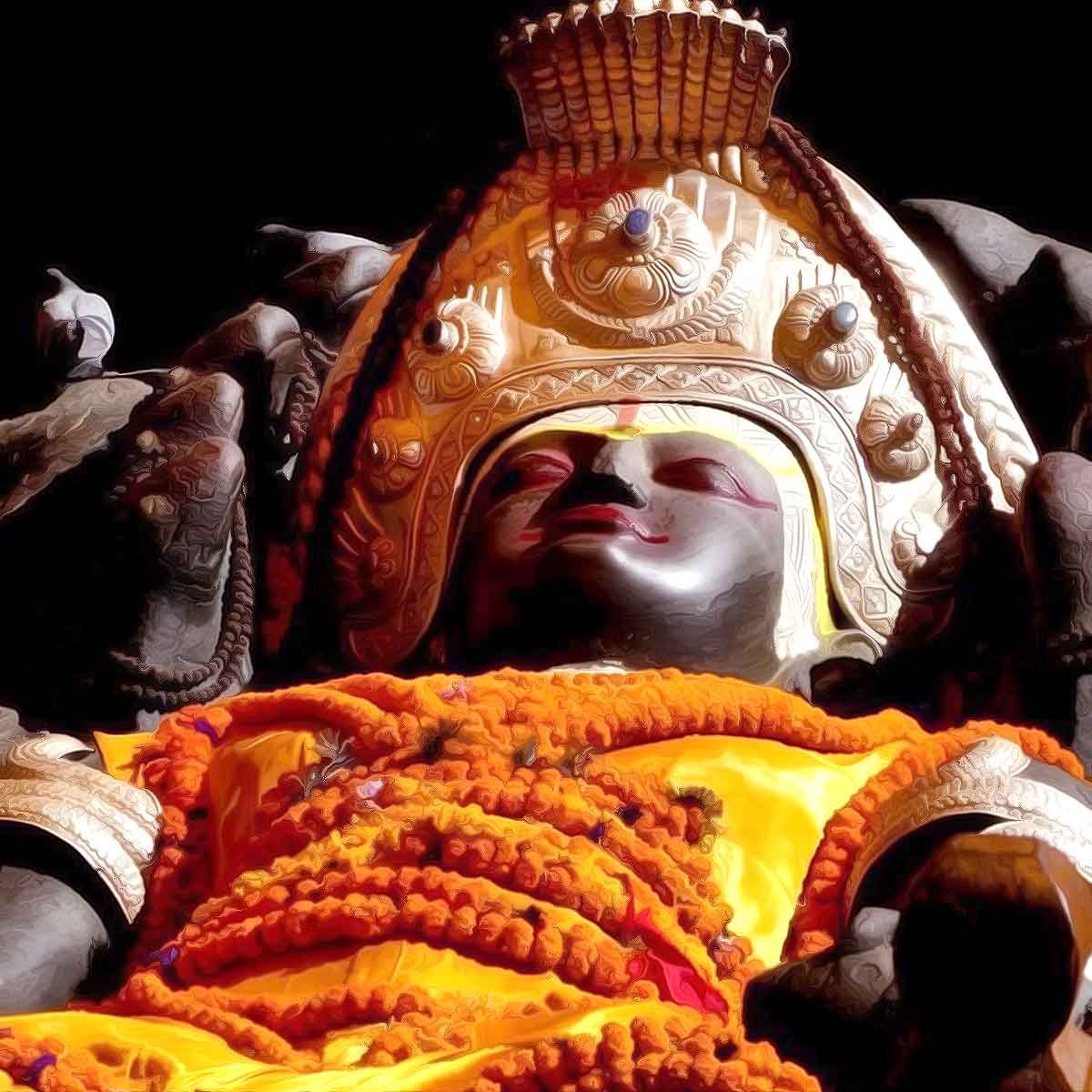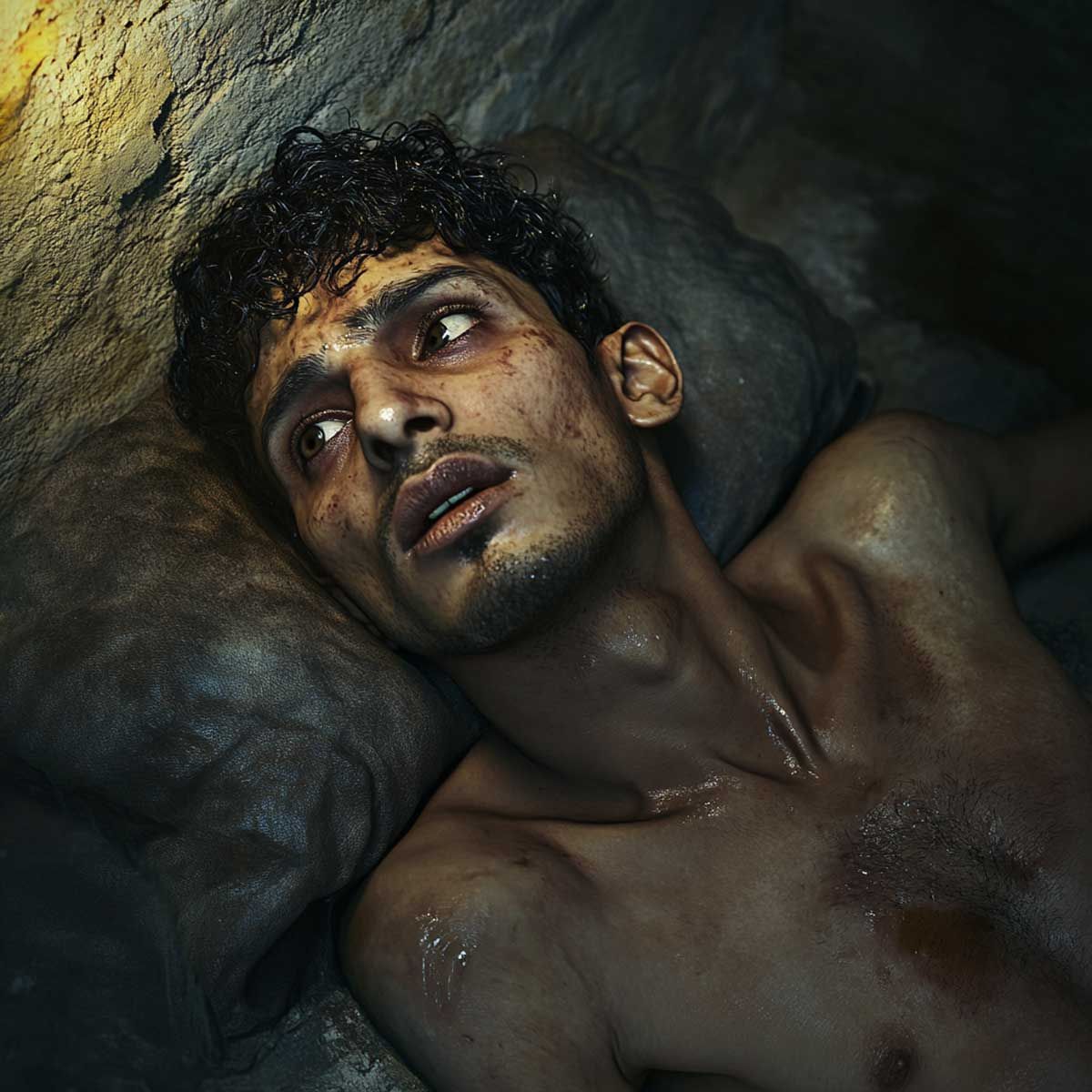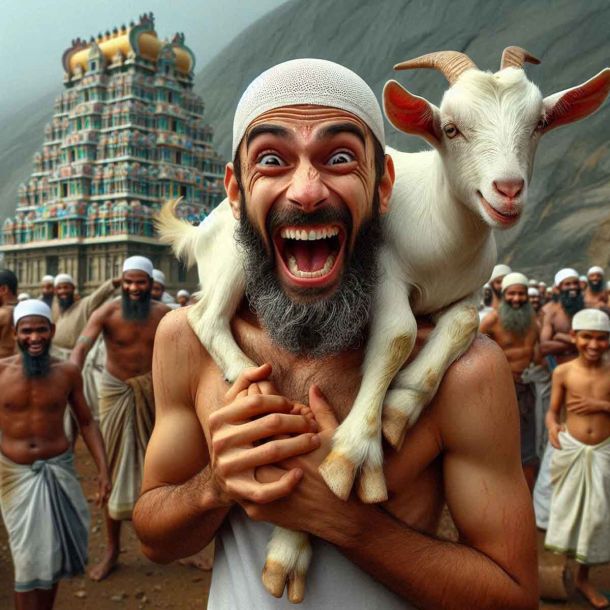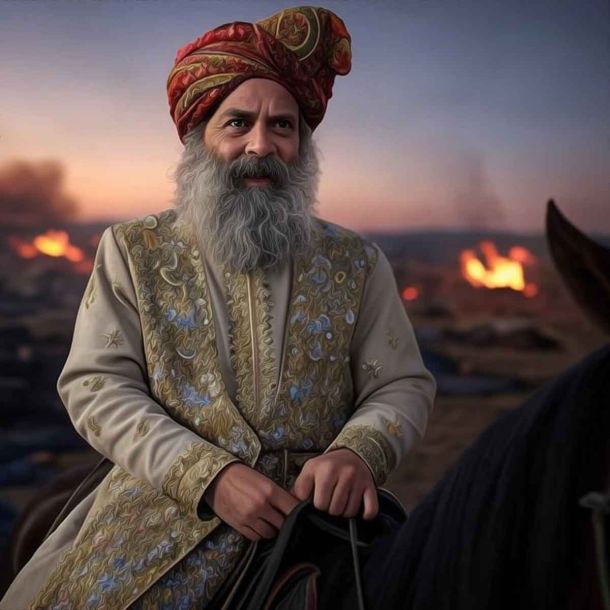More Coverage
Twitter Coverage
Satyaagrah
Written on
Satyaagrah
Written on
Satyaagrah
Written on
Satyaagrah
Written on
Satyaagrah
Written on
Join Satyaagrah Social Media
“True wisdom consists only in the knowledge of Brahman”: Budhanilkantha (Old Blue Throat) Temple, Nepal is a Hindu open air temple dedicated to Mahavishnu, also known as the Narayanan Temple, and can be identified by a large reclining statue of Mahavishnu

The Budhanilkantha Temple, also known as the Narayanan Temple, is a significant religious site located in Kathmandu, Nepal. It is renowned for its magnificent stone statue of Lord Vishnu, reclining on a bed of snakes in the middle of a sacred pond. The temple holds immense religious and historical importance, and its origins can be traced back to ancient times.
The history of the Budhanilkantha Temple dates back several centuries. According to local legends and historical accounts, the temple was built during the Licchavi period, which is believed to have existed from the 3rd to the 7th century CE. However, precise records regarding the temple's construction are scarce.
The Licchavi dynasty, known for its patronage of art, culture, and religion, played a vital role in the development of the temple. The dynasty, which ruled over the Kathmandu Valley during the ancient period, is said to have contributed to the construction and preservation of several temples, including Budhanilkantha.
The temple's primary deity, Lord Vishnu, is revered by both Hindus and Buddhists. The statue of Lord Vishnu in a reclining position is considered one of the largest stone sculptures in Nepal. The idol is approximately 5 meters long and is carved out of a single black basalt stone. The statue rests on a coiled serpent, representing the cosmic serpent Ananta, with Lord Vishnu reclining on its coils.
The sacred pond surrounding the statue, known as the Budhanilkantha Pond, is believed to hold great religious significance. The pond is fed by underground springs and is considered holy by devotees who believe that taking a dip in its waters can cleanse their sins and bestow blessings upon them.
Over the centuries, the Budhanilkantha Temple has undergone several renovations and restorations to maintain its architectural integrity and preserve its religious sanctity. The temple and its surroundings have been carefully preserved by the local community and devotees, ensuring its cultural and historical significance is maintained.
Today, the Budhanilkantha Temple continues to be a place of religious worship and pilgrimage for both locals and tourists. Devotees flock to the temple to offer prayers, perform rituals, and seek blessings from Lord Vishnu. The tranquil ambiance, serene surroundings, and awe-inspiring craftsmanship make it a popular destination for spiritual seekers and history enthusiasts alike.
The Budhanilkantha Temple stands as a testament to Nepal's rich cultural heritage, architectural brilliance, and religious diversity. It serves as a symbol of devotion and faith, attracting visitors from all walks of life who come to witness its magnificence and experience its spiritual aura. The temple's historical legacy and architectural grandeur make it an integral part of Nepal's cultural identity and a cherished site for the local community.
|
Mystery of Budhanilkantha Temple
The Budhanilkantha Temple in Nepal holds not only religious significance but also intrigues visitors and researchers with its mysterious elements. While the temple is revered as a place of worship, certain aspects have sparked curiosity and debate, contributing to the mystery surrounding it. Let's explore some of the intriguing aspects associated with the Budhanilkantha Temple.
Origin and Construction: The exact origins of the temple remain shrouded in mystery. While it is believed to have been constructed during the Licchavi period (3rd to 7th century CE), there is limited historical documentation to confirm this. The precise techniques and tools used in its construction also raise questions, as the intricate carving of the colossal stone statue of Lord Vishnu seems beyond the capabilities of ancient civilizations.
Massive Stone Statue: The centerpiece of the temple is a large stone statue of Lord Vishnu in a reclining position. The statue is carved out of a single black basalt stone and is estimated to weigh several tons. The craftsmanship and precision involved in creating such a massive sculpture during ancient times are astounding, adding to the mystery of its creation.
Uncovering the Statue: The discovery of the stone statue of Lord Vishnu is another enigma associated with the temple. According to local legends, a farmer accidentally struck the stone statue while plowing his fields, revealing the hidden treasure beneath the earth. The circumstances surrounding the statue's burial and subsequent discovery remain unclear, fueling speculation and intrigue.
Symbolic Significance: The symbolism behind the reclining posture of Lord Vishnu on a serpent and the significance of the Budhanilkantha Pond are subjects of interest. The serpent represents the cosmic serpent Ananta, and Lord Vishnu's reclining position symbolizes cosmic rest and preservation. The pond's sacredness and the belief in its purifying properties add to the mystique surrounding the temple.
Preservation of the Statue: The preservation of the stone statue over the centuries is remarkable. Despite being exposed to the elements, the statue has remained relatively unscathed, with minimal erosion or damage. The material used for its construction and the methods employed to protect it have puzzled experts and led to speculation about ancient preservation techniques.
Rituals and Mystical Experiences: Visitors and devotees often report unique and mystical experiences while visiting the Budhanilkantha Temple. Some claim to have felt a spiritual presence or experienced a sense of tranquility and energy within the temple premises. These anecdotal accounts add an element of mysticism and spiritual intrigue to the temple.
The mysteries surrounding the Budhanilkantha Temple continue to captivate researchers, historians, and visitors alike. While some mysteries remain unanswered, they contribute to the temple's allure and intrigue. The temple stands as a testament to the rich cultural heritage of Nepal and serves as a spiritual sanctuary for devotees and seekers of knowledge. Exploring the mysteries associated with the temple adds to the sense of wonder and appreciation for its profound historical and religious significance.
|
The architecture of Budhanilkantha Temple
The architecture of the Budhanilkantha Temple in Nepal showcases a harmonious blend of artistic brilliance, religious symbolism, and cultural heritage. The temple's architectural style is reflective of ancient Nepalese craftsmanship and temple architecture, with distinct elements that make it an architectural marvel. Let's delve into the details of the Budhanilkantha Temple's architecture:
Layout and Structure: The Budhanilkantha Temple follows a traditional Nepalese temple architectural style known as "Pagoda." It features a multi-tiered structure with a square base, gradually tapering towards the top. The temple is built on an elevated platform, emphasizing its sacredness and creating a focal point for worshippers.
Main Sanctum: The main sanctum of the Budhanilkantha Temple houses the magnificent stone statue of Lord Vishnu in a reclining position. The sanctum is a rectangular chamber adorned with intricate carvings and ornamentation. The entrance to the sanctum is marked by a beautifully carved doorway, often featuring depictions of deities, mythical creatures, and celestial beings.
Carvings and Ornamentation: The exterior and interior walls of the temple are adorned with exquisite carvings that depict various mythological stories, religious symbols, and divine figures. These carvings showcase the skill and craftsmanship of ancient Nepalese artisans. Intricate details, such as floral motifs, celestial beings, and religious iconography, are meticulously carved into the stone, adding to the temple's aesthetic appeal.
Pagoda Roof: The distinguishing feature of the Budhanilkantha Temple is its pagoda-style roof. The roof consists of multiple tiers, each receding in size as they ascend. The upward tapering design culminates in a pinnacle or finial, often embellished with metalwork or gold plating. The pagoda roof is characteristic of Nepalese temple architecture and adds a sense of grandeur to the temple's overall appearance.
Temple Materials: The Budhanilkantha Temple is primarily constructed using locally sourced materials. The main structure is built from brick and stone, while the intricate carvings and ornamentation are crafted from wood, stone, or metal. The use of these materials not only ensures durability but also showcases the mastery of ancient artisans in working with different mediums.
Sacred Pond: Adjacent to the temple is the Budhanilkantha Pond, which holds its own architectural significance. The pond is rectangular in shape and is surrounded by stone steps and balustrades. These features provide access to the water and create a serene environment for devotees. The pond's design aligns with the overall architectural aesthetics of the temple complex and adds to its visual appeal.
The architectural design of the Budhanilkantha Temple exemplifies the artistic prowess and cultural heritage of Nepal. Its intricate carvings, pagoda-style roof, and use of local materials showcase the mastery of ancient Nepalese craftsmen. The temple's design not only creates a sacred space for religious worship but also captivates visitors with its aesthetic beauty and architectural significance. The Budhanilkantha Temple stands as a testament to the rich architectural legacy of Nepal and continues to inspire awe and reverence among devotees and tourists alike.
|
Curse on the Royal family of Nepal, Budhanilkantha Temple
The Budhanilkantha Temple in Nepal is associated with various legends and stories, including the intriguing notion of a curse on the royal family of Nepal. According to local folklore, a curse was believed to have been placed on the royal lineage by a priest during the construction of the temple. Let's explore this legend and the curse associated with the Budhanilkantha Temple.
Legend has it that during the construction of the temple, a priest named Harsha Charudatta was tasked with overseeing the project. However, he was displeased with the behavior and actions of the then-ruling king, which he considered immoral and unworthy of his position. Filled with anger and frustration, the priest decided to invoke a curse upon the royal family.
The curse is said to have taken the form of a prophecy, foretelling the downfall of the dynasty and the eventual demise of the ruling family. It was believed that no king from the royal lineage would live to see old age or enjoy a peaceful life. This curse was said to be connected to the Budhanilkantha Temple and its sacred deity, Lord Vishnu.
Over the years, several events and incidents were attributed to the curse, further perpetuating the belief in its potency. Some claimed that the curse caused untimely deaths, tragedies, or misfortunes within the royal family. These incidents, along with the prophecy of the curse, created a sense of mystery and intrigue surrounding the temple and its connection to the royal lineage.
It is important to note that the curse is rooted in folklore and legend, and there is no concrete evidence to substantiate its existence or its impact on the royal family. However, it has become a part of the cultural narrative associated with the Budhanilkantha Temple and the history of Nepal.
It is worth mentioning that Nepal underwent significant political and social changes in recent decades, with the monarchy being abolished in 2008. The country transitioned into a democratic republic, and the political landscape transformed. This historical shift, unrelated to the curse, had a substantial impact on the role and influence of the royal family in Nepal.
The curse associated with the Budhanilkantha Temple adds an element of intrigue and mystique to the historical and cultural significance of the site. While it remains a part of local folklore, the temple continues to be revered as a sacred place of worship and a symbol of Nepal's rich heritage. Visitors can explore the temple, admire its architectural beauty, and immerse themselves in the spiritual ambiance, while also pondering the legends and stories that surround it, including the curse on the royal family.
 Support Us
Support Us
Satyagraha was born from the heart of our land, with an undying aim to unveil the true essence of Bharat. It seeks to illuminate the hidden tales of our valiant freedom fighters and the rich chronicles that haven't yet sung their complete melody in the mainstream.
While platforms like NDTV and 'The Wire' effortlessly garner funds under the banner of safeguarding democracy, we at Satyagraha walk a different path. Our strength and resonance come from you. In this journey to weave a stronger Bharat, every little contribution amplifies our voice. Let's come together, contribute as you can, and champion the true spirit of our nation.
 |  |  |
| ICICI Bank of Satyaagrah | Razorpay Bank of Satyaagrah | PayPal Bank of Satyaagrah - For International Payments |
If all above doesn't work, then try the LINK below:
Please share the article on other platforms
DISCLAIMER: The author is solely responsible for the views expressed in this article. The author carries the responsibility for citing and/or licensing of images utilized within the text. The website also frequently uses non-commercial images for representational purposes only in line with the article. We are not responsible for the authenticity of such images. If some images have a copyright issue, we request the person/entity to contact us at This email address is being protected from spambots. You need JavaScript enabled to view it. and we will take the necessary actions to resolve the issue.
Related Articles
- PM to unveil the 'Statue of Equality' of 11th century Vaishnavite saint Ramanujacharya: World’s second-largest statue in sitting position in Hyderabad on the 40-acre sprawling premises
- For the first time in the history of Puri Srimandir, 40 to 100 earthen hearths in the kitchen of Shree Jagannath Temple of Puri in Odisha were vandalized inside the Rosa Ghara
- "Festivals are like a map charting our spiritual progress in God": India is a land of temples and unique rituals, one such followed by devotees in a Karnataka Temple is Agni Keli, symbolizing the victory of good over evil integral to our cultural heritage
- Why Hindus not claiming their temples back from the Government control: Is pro-Hindu govt will always be in power
- RTI reply revealed that keys to the treasure room 'Ratna Bhandar' of Puri Jagannath temple which has a lot of gold, silver, and precious jewels donated by devotees and kings over the centuries have been ‘missing’ since 1970: Odisha
- ‘Lord Shiva helps creation sprout even from ruins, Humanity always wins over terrorism’: PM Modi launches key projects at Somnath
- “Sacred space is where you can find yourself over and over again”: Goa govt inked a MOU with Temple Connect to position Goa, popularly known as 'Bhagwan Parshuram Bhoomi', to be a global destination for spiritual tourism as 'Dakshin Kashi' of India
- Mahakal Temple in Ujjain to get expanded complex with Rs 714 crore in such a way that there will be a feeling of grandeur and divinity: Another reason for devotees to celebrate after Kashi Vishwanath corridor
- PM Narendra Modi inaugurated the Statue of Equality of Sri Ramanujacharya and emphasized 'Progressiveness does not mean detaching from one’s roots and that there is no conflict between progressiveness and antiquity.'
- "Temple will be an ever-present reminder that God intended the family to be eternal": Thirunakkara Mahadevar Temple situated in the heart of Kottayam is one of the 108 revered Shivalayas in Kerala, preserves sculptures and murals of Hindu deities
- After removing 500 tons of garbage, 18th-century old stepwell to soon serve with clean, fresh groundwater gushing from 53 feet deep water stream: Nalla Pochamma Temple, Telangana
- "Devotion evokes the mystery without which the world would not exist": Ancient Naga Devatha temple at Vidurashwatha located in Gauribidanur of Chikkaballapur district, Karnataka where people do prathishtapana of the divine naga to ward off Naga dosha
- In a significant discovery Hindu temple structure with ornate columns found inside a mosque in Mangaluru, locals suspect the presence of a temple in the past: VHP leaders asked to stop work till documents verified
- For the first time in the history of Tirupati, 30 devotees on foot stopped from reaching temple for carrying musical instruments up Tirumala hill by TTD: Devotees perform Nama Sankeerthanam during the journey
- 'Preserving state’s Cultural Heritage is important so Non-Hindus in Char Dham Yatra will have to undergo verification': Uttarakhand CM Pushkar Singh Dhami after concerns raised by Hindu religious seer
























